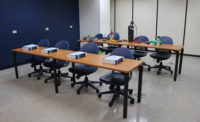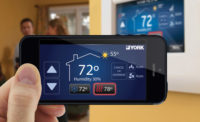The buildings of tomorrow are chock full of Internet of Things (IoT) devices and equipment that connect tenants, mechanical systems, and facility managers to up-to-the-minute data and progress reports.
“From an HVAC perspective, the IoT can help connect sensors, which are typically out on the edge, to wider systems,” said Paul Hepperla, vice president, North American solution sales, commercial and residential solutions, Emerson. “How these devices communicate and are used for control, interaction, and insight is where the IoT is most valuable for the HVAC side. Control systems have been utilizing machine-to-machine (M2M) interfaces for the past 20 years. This was really the forerunner to the IoT, which has changed this a bit by changing the technology that was centrally controlled out to sensors and reversing it to sensors at the edge that are now communicating up to a main system and providing real-time information.”
“I think the IoT is all about data,” said Udi Meirav, CEO, enVerid Systems Inc. “I think for HVAC systems, first and foremost, the IoT collects and transmits data from a location, such as in the field, to some other place. That is what this means. If I had to identify the single most important feature, it would be the sensors that allow you to collect more data and bring in other equipment. The data allows you to improve comforts and provide better conditions for people and does so more efficiently. The tool for that is fundamentally the collection of more and more information distributed throughout buildings for performance goals.”
KEY FEATURES
In new construction, there are key features that are most desirable by homeowners and contractors alike. When beginning new construction, security, storage, energy efficiency, connectivity, intelligent HVAC controls, and remote connection are among the most desirable features of IoT devices.
“The security feature allows for a secure cloud-based data storage and control protocol that ensures that only those who are approved at designated user levels have access to equipment data and control,” said John Marden, Intelligent Solutions service program manager, Daikin Applied. “The remote user is interacting with the cloud, not specifically with the HVAC equipment. Traditional building automation systems (BAS) require a remote connection directly to the equipment and the on-site BAS computer, which is only as secure as the BAS technician designed it.
“With storage, a cloud-based solution allows for collection, storage, and analytics of unlimited equipment data points,” Marden continued. “Memory and storage are unlimited versus in a BAS, where data is limited by the system memory capacity and adding memory requires extra programming and expense.”
In today’s day and age, efficiency is in high demand, and when building new homes, efficiency is a key feature homeowners are looking for to save money and reduce their carbon footprints.
“Efficiency is one of the more sought-after traits for building devices of all kinds, especially those that can save as much money as high-efficiency HVAC systems,” said Malcolm Persaud, senior manager, product and market development, air conditioning group, Panasonic Corp. “Panasonic products consistently deliver high SEER ratings for commercial units and seek to provide building owners with consistent solutions to help minimize their energy costs. Building systems that are designed to be smart and save building owners money will always be desirable. We are now at the point where smart device controls have become the minimum requirement and hands-free dynamic control is following close behind.”
An example is Panasonic’s ECO NAVI operation, which reacts to the occupancy and activity in a room and can perform area searches automatically.
“Products that combine high performance and energy efficiency often utilize features, such as motion sensors, remote accessibility, and smart thermometers, that adjust the output based on the existing temperature,” Persaud said. “These are just a few examples of some features that will soon become commonplace as internet connectivity takes on a bigger role in the construction industry.”
Connectivity is everything — customers want to be connected to their homes the same way they are connected to their bank accounts, Facebook profiles, and bills via apps on their phone. By offering customers the ability to choose between various communications platforms, you allow them to customize the way they are connected to their homes.
“The ability to choose either a cellular, Wi-Fi, or LAN communication platform gives contractors and building owners options for a secure connection to the equipment without the need to involve or pay for information technology (IT) resources as they may not trust a BAS on their IT infrastructure,” said Marden.
Intelligent equipment allows owners of new construction to operate more efficiently and with improved uptime. With self-diagnostics and alarms, problems can be solved even before a homeowner is aware there is a problem. A lot of this is credited to sensors.
“Today, we can capture hundreds of thousands of data points a day generated by system components and sensors and run algorithms to determine optimum sequences and maintenance priorities,” said Brian Ratcliff, U.S. ecobuilding services director, Schneider Electric.
“I think the most important thing is to include as many sensors as available, including building occupancy sensors, air quality sensors, etc.,” Meirav added. “Every building has sensors, but what if how much energy is used in every lightbulb, computer, etc. was able to be communicated? That is something more and more prevalent in the buildings of the future.”
Remote connection is perhaps one of the most sought after perks when constructing a new building. Contractors no longer have to go looking around an attic armed with a bundle of tools; they are sent the issue directly and made aware of the problem before they enter the home.
“The ability to remotely connect into a system, review, and troubleshoot the issues is critical for contractors,” said Hepperla. “This information allows them to determine if they have the parts on hand and how they are going to fix the issue. This information can be delivered to the technicians in the field to make the servicing as efficient as possible.”
OFFERING IT UP
As the buildings of tomorrow continue to change, manufacturers are sticking with the trends and developing products with the features that are in high demand by both consumers and contractors.
“Panasonic has been a solid brand name in the electronics field for 100 years, and we are proud to stand behind our products’ quality and reliability,” said Persaud. “As technology becomes more integrated, we are focusing more on contractor training, not only to service and maintain, but to sell and install as well. Our contractors will be trained to offer a full suite of service and installation options to customers in order to match our high standards for both product and service excellence; they are the heroes that drive our success.”
“Daikin Intelligent Equipment is pre-configured at the Daikin Applied factory for each specific piece of equipment,” said Marden. “Intelligent Equipment is plug and play from start-up. There is no need to wait for an expensive BAS programmer to connect and configure all the data points. All these data points are available to technicians on their smartphones, tablets, or computers immediately and stored in the secure Daikin Intelligent Equipment cloud. Any changes are stored and available for the entire lifespan of the equipment. This allows technicians and contractors to review any work or changes done to the equipment and bring it back to factory-recommended specifications without having to spend time looking up the specs for each unique piece of equipment.”
“Schneider provides state-of-the-art power solutions, metering, and building automation,” said Ratcliff. “While contractors don’t typically service our equipment, our systems are enablers for HVAC service companies to provide faster and better service to the building owners.”
The No. 1 benefit Emerson offers contractors is the ability to triage, a process that determines the issue, prioritization, or classification and how important the issue is, said Hepperla.
“Is it critical or can it wait eight hours or two days?” he asked. “Then who is this assigned to? The technician, an electrician, or a carpenter? That’s how we help contractors improve the quality of their service and maintenance.”
“We believe the next generation of IoT solutions will be focused on the products’ ability to operate in a non-connected sense as well as a connected product, provide energy efficiency, and interoperate with other connected equipment beyond today’s smart products,” said Gary Hsieh, director of product and business development, Lux Products Corp.
As technology continues to evolve, manufacturers are doing the same, creating smarter products for the buildings of tomorrow.
Publication date: 7/31/2017
Want more HVAC industry news and information? Join The NEWS on Facebook, Twitter, and LinkedIn today!










